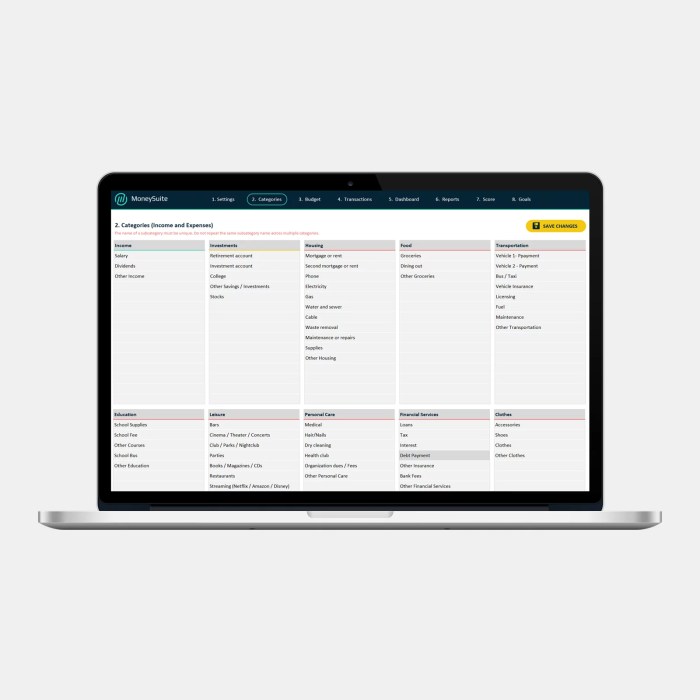Diving into the world of personal finance begins with creating a personal budget, a roadmap that guides you towards financial success. Let’s explore the art of budgeting and how it can transform your money management game.
Unpacking the steps to crafting a budget and the tools available to streamline the process will set you on a path to financial empowerment.
Importance of Creating a Personal Budget

In today’s fast-paced world, creating a personal budget is more crucial than ever. It serves as a roadmap for managing your finances effectively, ensuring that you are in control of your money rather than the other way around.
Benefits of Having a Well-Structured Budget
- Keeps track of your spending: A budget helps you monitor where your money is going, allowing you to make informed decisions about your expenses.
- Helps you save money: By outlining your income and expenses, a budget enables you to identify areas where you can cut back and save for future goals.
- Prevents overspending: With a budget in place, you are less likely to splurge on unnecessary purchases, helping you stay within your financial limits.
- Reduces financial stress: Knowing exactly where your money is going and having a plan in place can alleviate worries about money management.
How a Budget Can Help Individuals Achieve Their Financial Goals
- Setting priorities: A budget allows you to prioritize your financial goals, whether it’s saving for a vacation, buying a home, or paying off debt.
- Tracking progress: By regularly reviewing your budget, you can track your progress towards your financial goals and make adjustments as needed.
- Building wealth: A well-planned budget can help you build wealth over time by saving and investing wisely, ultimately leading to financial security.
Steps to Create a Personal Budget
Creating a personal budget involves several key steps that can help you manage your finances effectively and reach your financial goals.
Assessing Income Sources
When creating a personal budget, the first step is to assess all your sources of income. This includes your salary, bonuses, side hustles, rental income, or any other money coming in regularly. Knowing how much money you have available to budget is crucial for the next steps.
Tracking and Categorizing Expenses
After identifying your income sources, the next step is to track and categorize your expenses. This involves recording all your expenditures, such as rent, groceries, utilities, entertainment, and more. Categorizing expenses helps you see where your money is going and where you can potentially cut back to save more.
Setting Financial Goals within the Budget
Once you have a clear picture of your income and expenses, it’s essential to set financial goals within your budget. Whether it’s saving for a vacation, paying off debt, or building an emergency fund, having specific goals can motivate you to stick to your budget and make smarter financial decisions.
Reviewing and Adjusting the Budget Regularly
Lastly, it’s crucial to review and adjust your budget regularly. Life changes, unexpected expenses arise, and your financial goals may evolve over time. By reviewing your budget monthly or quarterly, you can ensure it stays relevant and aligned with your current financial situation.
Tools and Apps for Budgeting
When it comes to managing your personal finances, digital tools and apps can be incredibly helpful in creating and sticking to a budget. These tools offer features that can simplify the budgeting process and provide insights into your spending habits.
Mint
Mint is a popular budgeting app that allows you to track your income, expenses, and investments all in one place. It categorizes your transactions automatically and provides personalized financial insights.
YNAB (You Need a Budget)
YNAB is a budgeting tool based on the zero-based budgeting method, where every dollar has a job. It focuses on giving every dollar a purpose, helping you prioritize your spending and savings goals.
PocketGuard
PocketGuard is a personal finance app that gives you a snapshot of your financial situation in real-time. It tracks your income, expenses, and savings goals, helping you stay on top of your finances.
Tips for Sticking to a Budget
To successfully stick to a budget, it’s essential to have strategies in place to control impulse spending, prioritize expenses, and manage unexpected costs while staying within your financial plan.
Controlling Impulse Spending
- Avoid shopping when you’re emotional or stressed as it can lead to impulse purchases.
- Set a limit on discretionary spending each month and track it diligently.
- Consider implementing a waiting period before buying non-essential items to prevent impulse buys.
- Unsubscribe from marketing emails and avoid online shopping platforms to reduce temptation.
Prioritizing Expenses Within a Budget
- Identify essential expenses like rent, utilities, and groceries that must be paid first.
- Allocate a specific amount for savings and debt repayment before discretionary spending.
- Rank your expenses based on necessity and allocate funds accordingly to cover essentials first.
- Consider using the 50/30/20 rule where 50% of income goes to needs, 30% to wants, and 20% to savings and debt.
Managing Unexpected Expenses
- Build an emergency fund to cover unexpected costs without derailing your budget.
- Review your budget regularly and adjust allocations to accommodate unexpected expenses.
- Look for ways to reduce costs in other areas temporarily to cover unexpected expenses without going over budget.
- Consider using windfalls like tax refunds or bonuses to replenish your emergency fund after unexpected expenses.
